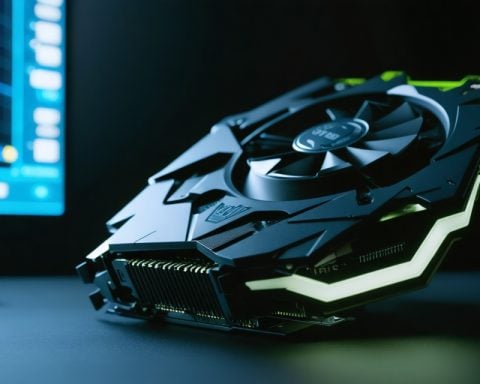- Nvidia faces supply chain disruptions impacting its AI-driven growth, with key supplier delays affecting product rollouts.
- Super Micro Computer revised its fiscal 2025 revenue projections due to setbacks in the Blackwell GPU and liquid cooling systems, with shipment delays extending into 2026.
- Vertiv Holdings reported strong quarterly results but anticipates weaker first-quarter performance, reflecting delays in AI component shipments.
- Additional supply issues involve PCIe 6.0, PMIC, and Semtech, indicating paused progress until later this year.
- Nvidia’s stock shows volatility, trading close to its 50-day moving average, and a potential drop below $110 may signal further declines.
- Acknowledging supply challenges in upcoming Q4 earnings could impact Nvidia’s stock, although strong performance from select systems might offer stability.
- Investors should prepare for a bumpy journey as Nvidia navigates uncertain waters despite its AI dominance.
Nvidia, the shining beacon of the AI era, now grapples with unforeseen challenges, as whispers from its suppliers cast a shadow over its technological throne. As supplier delays unfurl like a wrinkle on a crisp shirt, the once smooth ascent of Nvidia begins to stumble.
Typically optimistic, analyst Beth Kindig’s recent dive into vendor statements unveiled unsettling truths. Key partners murmured doubts about Nvidia’s GB200 NVL ambitions, hinting at a rougher path ahead than anticipated.
Super Micro Computer, a vital cog in Nvidia’s machine, dialed back its revenue forecast for fiscal 2025, citing delays in the Blackwell GPU rollout. The anticipated wave of racks with direct liquid cooling found itself pushed from mid-2025 whispering into early 2026. Alarming indeed, when Super Micro confessed its incapacity to ship volume systems for the forthcoming quarter—a signal of Nvidia’s potential near-term turbulence.
Vertiv Holdings, amid robust quarterly results, braced its stakeholders for softer horizons in the first quarter, highlighting “timing differences” in AI shipments. With essential suppliers like PCIe 6.0 and PMIC echoing similar concerns, their full-fledged contributions appear stalled until later this year. Notably, Semtech’s retreat on active copper cable guidance adds to the narrative of an uncharted path.
Yet, Nvidia’s stock dances on thin ice. Having cooled 2.83% year-to-date, it hovers near its 50-day moving average—an emblematic fence signaling the crack between bullish vigor and stagnation. Trading volumes fade and the RSI lingers at 50, hinting at withering enthusiasm. Any breach below the $110 mark could unveil a descent toward $100, a potential buying opportunity in Kindig’s eyes.
As Nvidia stands on the cusp of its Q4 earnings revelation, the truth looms. Acknowledgment of these supply strains might tip its stock further, yet robust performances from the Hopper and B200 systems could rescue its narrative.
Investors should buckle up. While Nvidia’s AI supremacy remains, the voyage forward seems more jagged than enthusiasts would prefer.
Nvidia’s Rocky Road: Navigating Supply Chain Snags and Market Volatility
How-To Steps & Life Hacks
For investors and tech enthusiasts watching Nvidia, here are some steps to navigate the turbulent waters:
1. Stay Informed: Regularly follow Nvidia’s announcements, especially around quarterly earnings, to understand the ongoing impact of supply chain delays.
2. Diversify Investments: While Nvidia has been a strong performer, consider diversifying to mitigate risks from industry and company-specific challenges.
3. Technical Analysis: Use technical indicators like RSI, moving averages, and volume to gauge stock movements and potential entry/exit points.
4. Monitor Competitors: Keep an eye on competitors and their developments in AI and GPUs, as these can influence Nvidia’s market position.
Real-World Use Cases
Nvidia’s GPUs are integral in several domains:
– AI Training and Inference: Widely used in data centers for AI tasks.
– Graphics Rendering: Essential for gaming and professional graphics industries.
– Scientific Research: Facilitates simulations and computations in physics, chemistry, and biology.
Market Forecasts & Industry Trends
The GPU market is expected to reach $200 billion by 2027, driven by AI, gaming, and professional visualization. Nvidia faces rising competition from companies like AMD and Intel.
Reviews & Comparisons
While Nvidia’s GPUs are unmatched in AI capabilities, AMD’s new RDNA architectures offer compelling performance-per-dollar, making them a viable alternative for budget-conscious users.
Controversies & Limitations
The delays in component supplies highlight Nvidia’s dependency on its ecosystem and vulnerabilities in its supply chain. Intel’s entrance into discrete GPUs also poses a long-term challenge.
Features, Specs & Pricing
Nvidia’s Blackwell GPU boasts improved power efficiency and performance but is delayed. Current models like the A100 and H100 remain high-demand but carry a premium price tag due to robust performance.
Security & Sustainability
Nvidia is working on improved security features in its DGX systems to protect large-scale deployments. Sustainability efforts focus on reducing energy consumption in data centers.
Insights & Predictions
While short-term headwinds persist, Nvidia’s long-term prospects remain strong due to continual advancements in AI and data center technologies. Expect fluctuating stock performance aligned with supply updates.
Pros & Cons Overview
Pros:
– Leader in AI hardware.
– Strong brand and technical innovation.
– Diverse applications across industries.
Cons:
– Supply chain vulnerabilities.
– High volatility in stock prices.
– Rising competition.
Actionable Recommendations
– Keep an eye on quarterly updates from Nvidia.
– Explore investing in ETFs that include a basket of technology stocks to spread risk.
– For tech enthusiasts, consider building systems with versatile architectures to mitigate supply impacts.
For further insights and real-time updates on tech stock movements, check Yahoo Finance and Reuters.



















